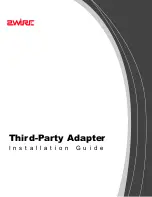
Crestron
e-Control
®
Software
routines and documentation for creating custom Web and PC-based interfaces that can
communicate with Crestron hardware.
The easiest method, requiring no knowledge of HTML, ActiveX or Java, is to create a
Web browser project using VisionTools Pro-e. You design a Web browser project in
much the same way as a touchpanel project. When you compile a browser project, VT
Pro-e converts the project pages into HTML format. The resulting files are then ready
to be uploaded to a Web server.
VT Pro-e provides two options for creating browser projects: one is Java-based, and
the other, referred to as “e-Control 2”, is based on Microsoft’s COM technology. With
e-Control 2, you also have the option to create a standalone executable that can be
launched from the Windows desktop (more on this later). To create a Java-based
project, you select
BROWSER
as the “panel type” in VT Pro-e; for a COM-based
project (e-Control 2), select
XPANEL
.
Java-based projects require that you license the e-Control portion of VT Pro-e in order
to enable the HTML conversion utilities. Crestron e-Control 2 requires that you enable
the C2ENET card; you do not have to license VT Pro-e. (Consult the documentation
for the C2ENET card for more information on how to enable the card for e-Control 2.)
Java-Based Browser Projects
When you design a Java-based project, each object that you draw on a page is actually
a discrete Java
applet
. Applets are small, self-contained programs that can be attached
to HTML pages to make them dynamic and interactive.
When you use a Java-enabled Web browser to view a page that contains an applet, that
applet's code is transferred to your system and executed by the browser's Java Virtual
Machine (JVM). (Crestron distributes a copy of the latest Microsoft JVM with each
version of VT Pro-e.) VT Pro-e automatically adds a Java communication component
to each Web page when the project is compiled, allowing the Java applets to connect
to the e-Control gateway and send and receive digital, analog and serial signals to the
control system.
Java-based projects require special design considerations because of the overhead
incurred by transferring Java applets each time a page is loaded or refreshed. For
example, to reduce download time, the Web pages should be as simple and uncluttered
as possible, with a minimum number of graphics. In addition, subpages should be used
sparingly, if at all. Subpages are opened in a new browser window that the user can
resize or reposition, which can lead to undesirable results.
Finally, you need to test projects with Web browsers such as Netscape Navigator,
since the page display and layout can vary widely depending on the JVM. For
example, layered objects, which are commonly used in VT Pro-e projects, may look
and behave differently depending on the browser.
XPANEL Projects (e-Control 2)
The purpose of e-Control 2 is to give e-Control Web pages (or standalone executables)
the same look and feel as TPS touchpanel pages, with almost none of the overhead
associated with Java-based projects. Crestron e-Control 2 uses industry-standard COM
technology designed specifically for Microsoft Internet Explorer and Windows.
XPANEL projects differ from Java-based projects in several important ways. First,
XPANEL projects are multi-mode, allowing you to make full use of the same design
Reference Guide – DOC. 6052
Crestron e-Control®
•
33
Содержание e-Control
Страница 1: ...Crestron e Control Reference Guide...
Страница 62: ...Software Crestron e Control 58 Crestron e Control Reference Guide DOC 6052...
Страница 63: ...Crestron e Control Software Reference Guide DOC 6052 Crestron e Control 59...
Страница 71: ...Crestron e Control Software This page intentionally left blank Reference Guide DOC 6052 Crestron e Control 67...
Страница 72: ......
Страница 73: ...Crestron e Control Software This page intentionally left blank Reference Guide DOC 6052 Crestron e Control 69...
















































